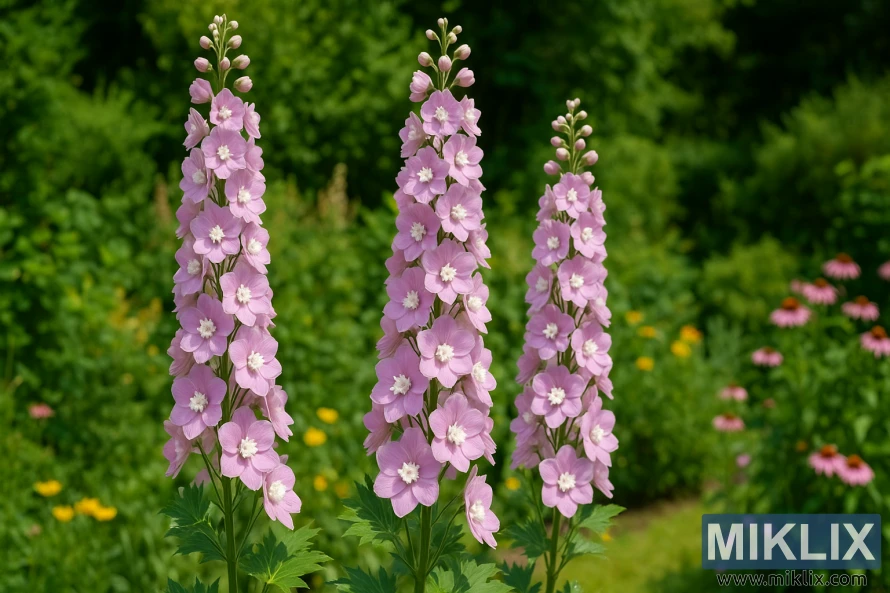Image: Delphinium 'Guinevere' in Full Bloom with Lavender-Pink Flowers
Published: October 25, 2025 at 4:20:57 PM UTC
A high-resolution image of Delphinium 'Guinevere' in full bloom, featuring tall lavender-pink flower spikes with striking white bee centers, surrounded by lush foliage and complementary perennials in a cottage-style garden.
The image captures a stunning garden portrait of Delphinium ‘Guinevere’, a classic cottage garden perennial renowned for its soft pastel beauty and graceful vertical form. Set in a lush, naturalistic border and bathed in warm daylight, the scene focuses on four prominent flower spikes rising elegantly above a sea of green foliage. Each towering stem is densely lined with blossoms, creating a vertical emphasis that draws the viewer’s eye skyward and emphasizes the structural drama these plants bring to the summer garden.
The flowers of Guinevere are a delicate lavender-pink — a hue that shifts subtly in the sunlight, from dusty rose to pale lilac, depending on the angle and intensity of the light. Their petals are smooth, rounded, and slightly overlapping, forming a loose, elegant rosette shape around the flower’s center. The blossoms are arranged in a spiral pattern up the tall, sturdy stems, opening progressively from the base toward the top. Near the spike tips, unopened buds form tight clusters, hinting at future blooms and adding a sense of ongoing growth and vitality to the image.
At the heart of each flower lies the most distinctive feature of this cultivar: the brilliant white “bee” center. These fuzzy, petal-like structures are composed of modified stamens and filaments, forming a small tuft that contrasts sharply with the soft pastel petals. This bold center not only enhances the flower’s visual appeal but also serves as a beacon for pollinators. The contrast between the luminous white centers and the lavender-pink petals gives the flowers depth and definition, preventing them from blending into the background despite their delicate coloration.
The foliage at the base of the plants is lush and deeply lobed, with broad, serrated leaves that form a dense green foundation for the towering flower spikes. Their rich emerald color enhances the pastel tones of the blooms and provides a natural backdrop that anchors the vertical composition. The sturdy stems — essential for supporting the tall flower spikes — are thick and upright, suggesting careful cultivation and possibly discreet staking to prevent the plants from bending under their own weight.
In the background, the garden unfolds into a softly blurred tapestry of complementary perennials and foliage. Pink Echinacea (coneflowers) and golden Rudbeckia (Black-eyed Susans) add splashes of contrasting color, while a variety of green shrubs and herbaceous plants create depth and texture. The interplay of these companion plants enhances the overall composition, giving the scene a layered, painterly quality typical of well-designed cottage gardens.
Light plays a crucial role in the image. The soft, natural sunlight brings out the delicate tonal variations in the petals, casting gentle shadows that accentuate the flowers’ three-dimensional structure. The subtle highlights on the white bee centers make them almost luminous, while the darker greens of the background provide contrast that makes the pastel spikes stand out even more vividly.
Overall, the image is a perfect representation of Delphinium ‘Guinevere’ at its peak: elegant yet bold, delicate yet commanding. Its graceful pastel blooms add a romantic, ethereal quality to the garden, while the strong vertical form and striking white centers ensure it remains a focal point even in a richly planted border. The scene encapsulates the timeless charm of English garden design — a harmonious blend of color, structure, and texture that celebrates the beauty of nature in full bloom.
The image is related to: 12 Stunning Delphinium Varieties to Transform Your Garden

